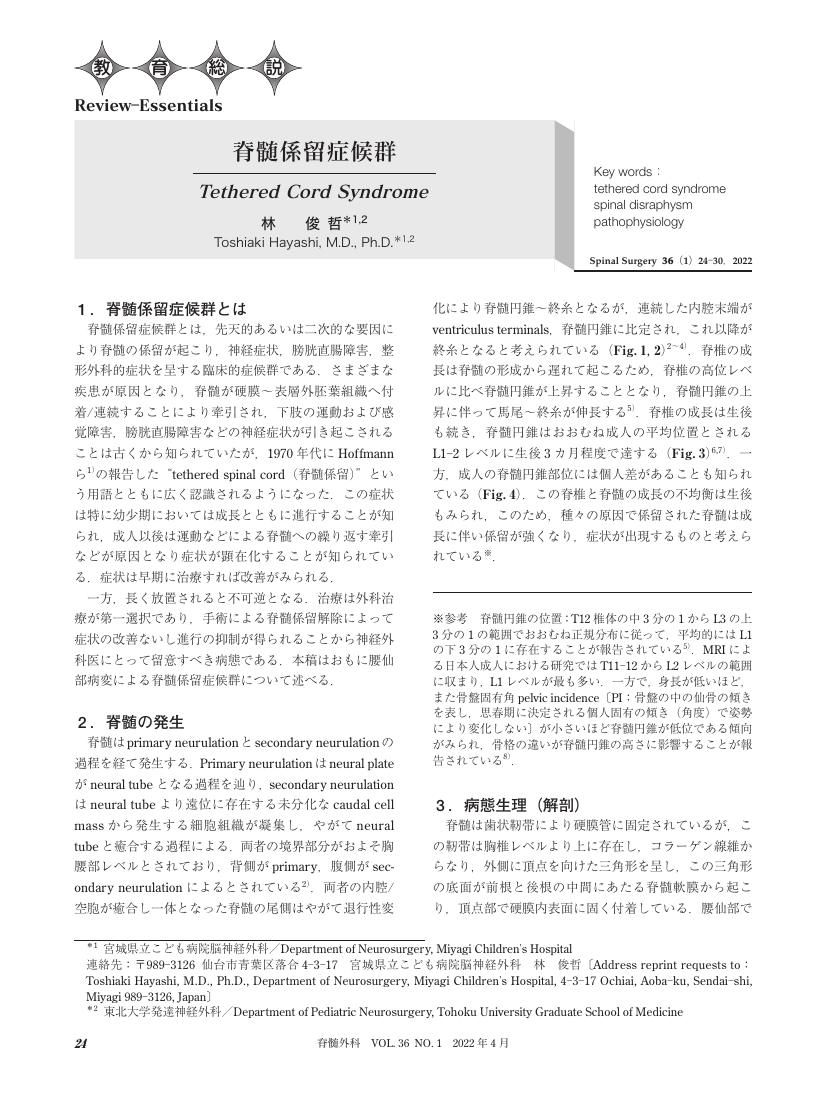10 0 0 0 OA 脊髄係留症候群
1 0 0 0 OA 中頭蓋窩くも膜のう胞破裂後の硬膜下血腫/水腫にTBIRDを合併した乳児例
- 著者
- 君和田 友美 林 俊哲 白根 礼造 冨永 悌二
- 出版者
- 一般社団法人 日本小児神経外科学会
- 雑誌
- 小児の脳神経 (ISSN:03878023)
- 巻号頁・発行日
- vol.47, no.4, pp.414-418, 2022 (Released:2023-01-30)
- 参考文献数
- 12
右中頭蓋窩くも膜のう胞破裂後に硬膜下血腫/水腫を来し,けいれん重積型(二相性)急性脳症に類似の病態であるinfantile traumatic brain injury with a biphasic clinical course and late reduced diffusion(TBIRD)を併発した1乳児例を報告した.新生児/乳幼児急性硬膜下血腫後に脳腫脹を来す一因として,我々脳神経外科医はTBIRDを十分理解しておく必要がある.
1 0 0 0 OA 高齢者頭部外傷の特徴と問題点
- 著者
- 刈部 博 林 俊哲 平野 孝幸 亀山 元信 中川 敦寛 冨永 悌二
- 出版者
- 一般社団法人日本脳神経外科コングレス
- 雑誌
- 脳神経外科ジャーナル (ISSN:0917950X)
- 巻号頁・発行日
- vol.23, no.12, pp.965-972, 2014 (Released:2014-12-25)
- 参考文献数
- 54
- 被引用文献数
- 10 5
高齢者頭部外傷は予後不良とされ, 病態の解明, 治療法の開発, 予防への取り組みは, 高齢化社会を迎えた本邦における喫緊の課題である. 本稿では, その特徴と問題点について言及・考察する. 高齢者頭部外傷は運動機能や生理機能の低下による転倒・転落が多い. 急性期頭蓋内病変では急性硬膜下血腫の頻度が高く, 血腫量が多いことが特徴で, 加齢による硬膜下腔の拡大など解剖学的特徴に起因する. また, 遅発性頭蓋内血腫や脳血流変化など, 解剖学的・生理学的特徴に関連する病態も高齢者に特徴的である. 近年普及した抗凝固・血小板療法は, 頭蓋内出血増悪の一因であり, さらに治療を困難にしている. 今後, さらなる研究が期待される.
1 0 0 0 OA スポーツ関連外傷性閉塞性脳血管障害の特徴―リスク因子としての頸部過伸展・過回転の重要性―
- 著者
- 刈部 博 林 俊哲 成澤 あゆみ 赤松 洋祐 亀山 元信 中川 敦寛 冨永 悌二
- 出版者
- 一般社団法人 日本神経救急学会
- 雑誌
- Journal of Japan Society of Neurological Emergencies & Critical Care (ISSN:24330485)
- 巻号頁・発行日
- vol.30, no.2, pp.1-8, 2018-06-01 (Released:2018-11-15)
- 参考文献数
- 21
In this study, eleven cases with sports-related traumatic occlusive cerebrovascular accident (OCVA) are investigated to clarify clinical characteristics by reviewing following clinical factors: age, gender, mechanism of trauma, symptom, type of sports, duration between the time of injury and outpatient visit or diagnosis, type and site of vascular injury, co-existent traumatic intracranial lesion, treatment, and outcome. Traumatic OCVAs were accounted for 9.1% of sports-related TBI, as 1.1% of other TBIs than sports-related. It is more common in male than female. Histogram of age distribution demonstrated a peak at the age of 5-14 y.o. Cervical hyperextension and/or hyper-rotation was the most common mechanism of injury. Head and/or neck pain immediately after trauma was the most common initial symptom. The most frequent vascular lesion was an arterial dissection of internal carotid or vertebral artery. Antiplatelets or anticoagulants were introduced for treatment in cases without traumatic intracranial hematoma. Favorable outcomes were obtained in most cases, however, permanent neurological deficits were remained in 3 cases. Since delay in the introduction of treatment results in poor functional outcome, an early visit of outpatient are quite important in patients with sports-related traumatic OCVAs, as well as the standardization of diagnostic algorithm.
- 著者
- 白根 礼造 林 俊哲 三宅 裕治 冨永 悌二
- 出版者
- 日本脳神経外科コングレス
- 雑誌
- 脳神経外科ジャーナル (ISSN:0917950X)
- 巻号頁・発行日
- vol.19, no.7, pp.510-517, 2010
- 参考文献数
- 21
- 被引用文献数
- 1
脳神経外科医にとって最初の関門であるシャント手術ではあるが,専門医取得後には真剣に向き合う機会は少ないと考える.昨今のシャントシステムの発展は驚嘆に値し,小さなシステムの中にさまざまな機能を含んでいて,経験を積まなければそのすべてを理解するのは困難であろう.しかし,個々の症例に対し適切なシステムを選択し,バルブ固有の特性に関して必要十分な説明を行うことは医療者側の責任である.本論文では,患者背景による水頭症病態の差異,髄液シャントの歴史的背景,現在普及しているシャントバルブの基本理念および特性,シャント手術に際しての注意点に関して解説した.
